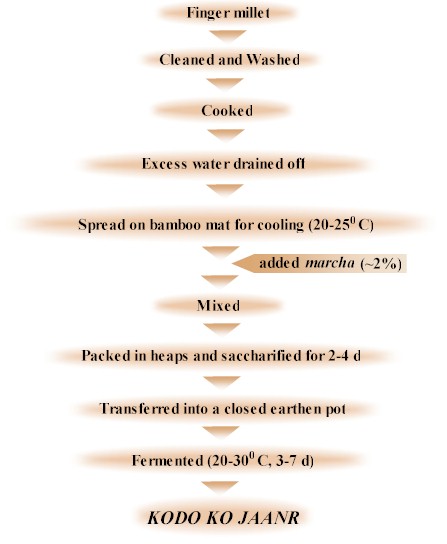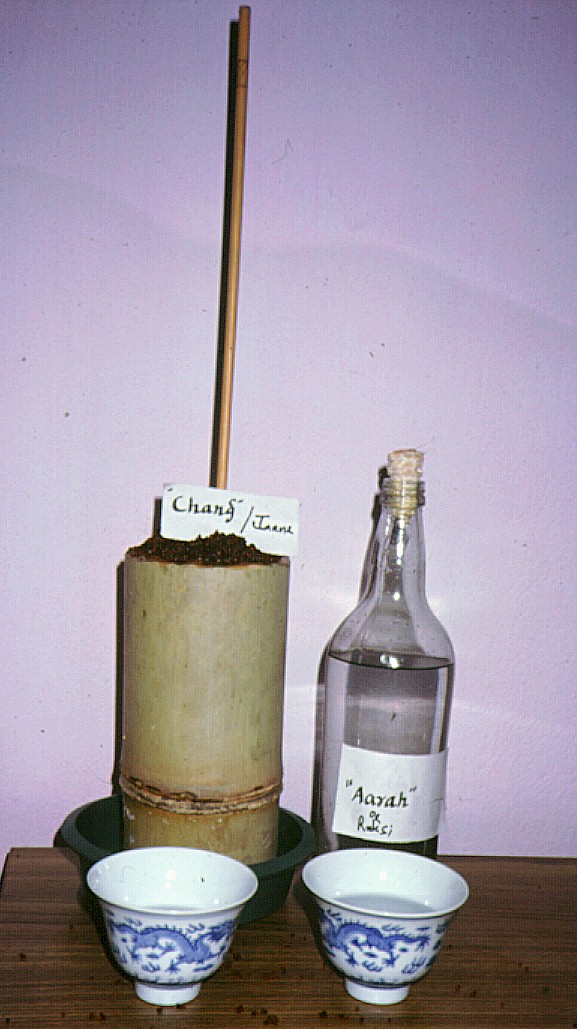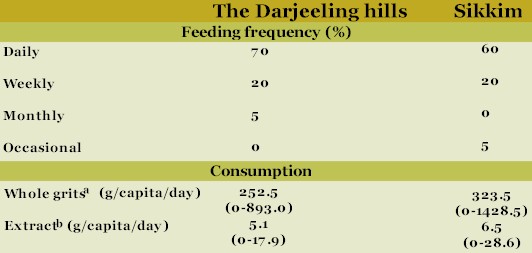| TRADITIONAL FERMENTED FOODS AND BEVERAGES OF THE SIKKIM HIMALAYAS |
 |
Kodo ko jaanr is the most common fermented beverage prepared from dry seeds of finger
millet [Eleusine
coracana (L) Gaertn.], locally called ‘kodo’ in the Darjeeling hills
and Sikkim. Jaanr is common name
for all alcoholic beverages in Nepali. Different ethnic groups call it by
their own dialect such as mandokpenaa
thee by Limboo, sampicha ummaak by Rai, naarr paa by Gurung, saangla
chi by Tamang, chirs shyaabu by Sunwar, paadaare haan by Magar, gyaar chyyaang by Sherpa, minchaa
chhyaang by Bhutia, and mong chee by Lepcha.
|

|
|
During traditional method of kodo
ko jaanr preparation, seeds of finger millet are cleaned, washed and
cooked for about 30 min in an open cooker. Excess water is drained off and
spread on a mat made up of bamboo, locally called mandro, for cooling. About
1-2% of powdered marcha, dry mixed starter, is sprinkled over cooked seeds, mixed
thoroughly and packed in a bamboo basket lined with fresh fern, locally
called ‘thadre unioon’ (Thelypteris
erubescens Well ex Hook.) or banana leaves, then covered with sack
clothes, and kept for 2-4 days at room temperature for saccharification.
During saccharification sweet aroma is emitted out and the saccharified
mass is transferred into an earthen pot or into specially made bamboo
basket called ‘septu’ and made it air tight, and fermented for 3-4 days
during summer and 5-7 days in winter at room temperature (Fig 8).

Fig.
8. Flow sheet of Kodo ko jaanr preparation in East Sikkim.
Good
quality of jaanr has sweet taste
with mild alcoholic flavour. Prolonged fermentation makes the product
bitter in taste and more alcoholic. Sour taste and unpleasant flavour of jaanr is unacceptable to consumers.
|

|
 |
Kodo
ko jaanr is consumed in an unique way in the Himalayan regions. About
200-500 g of kodo ko jaanr is put into a vessel called toongbaa and
lukewarm water is added up to the edge of the toongbaa.  A A fter 10-15
min, milky white extract of kodo ko jaanr is sipped through a narrow bamboo
straw called pipsing having a hole in a side near the bottom to avoid
passing of grits. Water can be added 2-3 times after sipping up the extract.
Guests are served with toongbaa along with fried meat or pickles.
Alternately, thick milky white liquid pressed from the kodo
ko jaanr is filtered using a filter called chhapani under
pressure. Such liquor is believed to be good tonic for ailing persons and
post-natal women. After consumption, grits of kodo ko jaanr are used as
fodder for pigs and cattle. This is a good example of total utilization of
substrate as food and fodder. Feeding frequency of kodo
ko jaanr has been summarised in Table 3. About 70 % of people consume
kodo ko jaanr daily in rural areas of the Sikkim Himalayas. Per capita daily
consumption of kodo ko jaanr extract in the Darjeeling hills and Sikkim is
5.1 ml and 6.5 ml, respectively (Tamang et
al., 1996). fter 10-15
min, milky white extract of kodo ko jaanr is sipped through a narrow bamboo
straw called pipsing having a hole in a side near the bottom to avoid
passing of grits. Water can be added 2-3 times after sipping up the extract.
Guests are served with toongbaa along with fried meat or pickles.
Alternately, thick milky white liquid pressed from the kodo
ko jaanr is filtered using a filter called chhapani under
pressure. Such liquor is believed to be good tonic for ailing persons and
post-natal women. After consumption, grits of kodo ko jaanr are used as
fodder for pigs and cattle. This is a good example of total utilization of
substrate as food and fodder. Feeding frequency of kodo
ko jaanr has been summarised in Table 3. About 70 % of people consume
kodo ko jaanr daily in rural areas of the Sikkim Himalayas. Per capita daily
consumption of kodo ko jaanr extract in the Darjeeling hills and Sikkim is
5.1 ml and 6.5 ml, respectively (Tamang et
al., 1996).
|
| |

Table: Feeding frequency and consumption of kodo ko jaanr.
Weekly
means twice in a week. Occasional means every three months.
aAmount
of fermented millets kept in toongbaa without addition of water was calculated.
bExtract
of fermented grits after addition of water, actually sipped has been
calculated. Data represent the means.
Values are the means of 100 households each in
rural areas of the Darjeeling hills and Sikkim, respectively. Ranges are
given in parentheses.
|

|
 |
Traditional
alcoholic beverages have strong ritual importance and are deep-rooted in the
cultural heritage of the various ethnic groups of people in the Darjeeling
hills and Sikkim. In these regions social activities require provision and
consumption of appreciable quantities of alcoholic beverages by the
‘matwali’ castes meaning alcohol drinkers of the non-Brahmin Nepali
community mostly Limboo, Rai, Gurung, Magar, Tamang, Sunwar, Newar and
Sherpa the Bhutia and the Lepcha tribes. Jaanr and raksi are essential to
solemnize marriage ceremony of non-Brahmin Hindu Nepalis and the Buddhist
tribes. Fermented beverages are offered to perform the
pitri puja or kul puja, the
religious practice to pray family Gods and Goddesses. Among the Lepcha, mong
chee or kodo ko jaanr is essential to perform various cultural functions
such as lirum, sejum and namsung.
Mandokpenaa thea or kodo ko jaanr, filled in toongbaa and rice-made raksi
are among the important materials to perform the ritual practice of the
Limboo called tonsin mundhum. In
mourning, callers for condolences gathered to perform a memorial service are
served traditional alcoholic beverages, a practice mostly seen among the Sherpa and the
Bhutia tribes. Spirit possession by the Limboo priests called phedangma and bijuwa need
freshly distilled raksi.
|
|